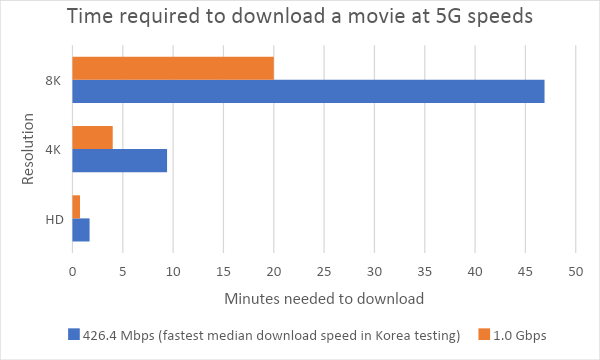5G video will be driven by speed, capacity, and latency
Suzanth Subramaniyan at RootMetrics delivers his verdict on the future for 5G video.

With the first commercial 5G networks now live and the first 5G-enabled devices in the marketplace, the stage is set for 5G video to not just have an impact on current viewing habits, but to help foster use cases that are now only nascent or not even started. It’s an exciting and disruptive time, with 5G likely to catalyze both further growth and additional fragmentation of how users consume video.
The impact of fragmentation
To understand how 5G video will help transform broadcasting and consumption, it’s important to step back and evaluate the current landscape. We’ve already seen OTT services have a massive impact on the traditional broadcasting model. Netflix, Hulu, Amazon Prime, YouTube, and others have helped fragment the video landscape. Cable and satellite companies have responded by offering set-top boxes that attempt to lure users in with a combination of live TV, VOD content, and even the ability to connect to various OTT video apps.
Other applications and cultural shifts suggest that the fragmentation of video viewing will increase rather than stabilize - at least in the near future. The massive money tied to eSports and its increased popularity on both Twitch and traditional broadcasting show that the eSports live streaming market has continued growth ahead. TikTok and YouTube also appear positioned for additional expansion, and even traditional text messaging is being replaced (or at least supplemented) by video-enabled chat services.
In short, the current video landscape has shifted from old-style broadcasting toward an experience that enables individuals to consume video content on their own schedules. Even the location of video consumption has changed, moving from the family room to anywhere a mobile connection can be found. It’s a landscape characterized by more video content, delivered by more providers, consumed in more places. Within this increasingly fragmented environment, excitement is high for 5G video because of three key areas: speed, capacity, and latency.
5G video: speed
From a video standpoint, the blazing speeds of 5G will help enable near-instantaneous streaming and much faster downloads. Those faster speeds will become even more critical as 4K and, eventually, 8K content grows. With massive file sizes compared to today’s high-definition video, a fast 5G download speed will be needed to assure a smooth end-user experience. Consider, for example, the following differences in time needed for a consumer to download different resolutions of a movie at the fastest median download speed we saw while on 5G mode during testing in South Korea, along with the time required at the 1.0 Gbps 5G threshold.

5G video: capacity
There’s more than just speed to consider, however. The expansion of 5G also promises dramatic improvements in capacity. As video consumption—especially for larger 4K and 8K file sizes—grows, capacity will become more and more important to support more devices and more data-intensive video.
Indeed, 5G capacity will be instrumental to the growth of enhanced mobile broadband (eMBB) to deliver a seamless experience to users and devices/things in crowded situations, during daily commuting, or any other data experience on the move. In short, the improved capacity of 5G will not only support but likely fuel increased video consumption.
SIGN UP FOR E-MAIL NEWSLETTERS
Get up to speed with 5G, and discover the latest deals, news, and insight!
5G video: latency
The lower latency offered by 5G will also be critical to the growth of video. Simply put, latency refers to the lag between a user request and action being taken by the network. The lower latency of 5G will assure no-lag video consumption and the immediate initiation of any download request. Buffering will become a thing of the past.
Taken together, the fast speeds, extended capacity, and ultra-low latency of 5G promise not just to lead to an expansion of current video consumption habits but also to foster continued fragmentation and alternate video formats. We expect to see, for instance, increased live streaming, VR-enabled content, and multi-channel broadcasting options that offer viewers a choice of alternative viewing angles for the same content. These data-heavy options are not possible for operators to deliver until mobile operators transition to 5G.
5G video today
The speed, capacity, and latency of 5G will be critical to the future of video consumption, but we haven’t yet seen consistency across those three areas in initial 5G network deployments. That isn’t necessarily a surprise and shouldn’t dampen long-term enthusiasm. Any new technology must mature and work through growing pains.
There’s work still needed before 5G can create a foundation for a smooth, video-everywhere experience. Consider, for example, that we only recorded 5G network availability in approximately 40-45% of our testing in South Korea. 5G availability was even lower during our initial testing in the US. AT&T, T-Mobile, and Verizon never exceeded 5G availability rates of 7.1% during our testing in Atlanta, Chicago, and Dallas. Sprint offered greater availability, but its speeds trailed those found in Korea.
The spectrum resources different operators have available also complicates the availability of 5G. Operators with mmWave spectrum (practically speaking, consider mmWave as frequencies above 6 GHz) will face greater difficulties assuring coverage in buildings or across larger distances because of its difficulty penetrating solid objects, with a range limited to approximately one city block. Operators with spectrum in lower frequencies (below 6 GHz) won’t have the same coverage difficulties due to propagation, but top-line speeds will also be lower than what mmWave can potentially offer. In short, the tradeoff becomes a matter of offering potentially slower speeds but broader coverage with sub-6 GHz spectrum or offering faster speeds but less reliable coverage with mmWave spectrum.
We’re similarly looking closely at issues that are impacting latency. Best-case latency figures are grabbing headlines, but pull back the curtain and you’ll find roadblocks that are still being worked through. To show how latency impacts various consumer activities, we test 5G across multiple end-user scenarios. We’ve found that latency during activities that require continuous activity with a 5G network (such as streaming video) is generally quite good, but latency lags during activity reflective of downloading a large file (such as a user downloading, rather than streaming, a movie).
The reason for this discrepancy comes back to the need for a network to shift from LTE to 5G. During this type of “upswitching,” an initial delay occurs that impacts latency and is felt most during the download of a large file such as a video. Time to first frame and buffering could continue to be issues as long as upswitching from LTE to 5G is required. For video tasks that involve VR or streaming, upswitching will impact latency only at the very start of the request, with the user experience likely smoothing out thereafter. Until the worst-case user experience for speed, availability, and latency can be improved, 5G will continue to have an important but at times limited impact on video.
5G video tomorrow
As 5G continues to expand, we’re keeping our eye on several impending improvements (and some potential obstacles) that promise to impact video growth and the consumer video experience. For instance, as 5G coverage grows, users in rural areas will find greatly increased video options. This expansion of 5G-powered video services, however, could introduce additional capacity issues and more fragmentation across video services, potentially leading to a second wave of the issues that have gained a foothold today.
On the bright side, there are several improvements in 5G network architecture (on top of the 5G air interface) that will help foster the growth of video streaming. A software-defined infrastructure enabled by 5G may be the launch pad to a fully virtualized network, where network slicing will help operators prioritize traffic for different applications during periods of congestion. Video content providers will place content delivery nodes closer to the edge (for instance, at cell towers), and processing at the edge will greatly increase efficiency and reduce costs for both content providers and network operators. While video at the edge has been stalled because latency and reliability have been insufficient, the growth of 5G networks will erase those limitations and greatly reduce the round-trip time needed to process and deliver requests. By taking advantage of efficiencies that save both time and cost, 5G will open up new possibilities for video content providers to host ever-increasing amounts of content at the edge.
While there are issues still to be addressed, 5G promises to unlock a bright future for video. Operator networks are improving every day, and we anticipate a significant jump forward over the next year. We’ll continue testing 5G performance under real-world conditions to help show when 5G is primed for supporting all of these amazing video changes on the horizon, as well as to help identify any new obstacles that might emerge.
- Get the latest 5G stocks news today
- We reveal how 5G technology works
- Here's what to expect from 6G in 2030
- 5G dangers: the fact and the fiction
- Will 5G Internet replace fibre broadband?
Suzanth Subramaniyan is Director, Radio Access Networks, at RootMetrics by IHS Markit. RootMetrics helps provide insights that can improve the end-user mobile experience. RootMetrics accurately shows how consumers experience mobile performance, and provides information free to the public, whilst offering deeper insight to the mobile industry so that they can make improvements that benefit the consumer’s daily mobile life.

